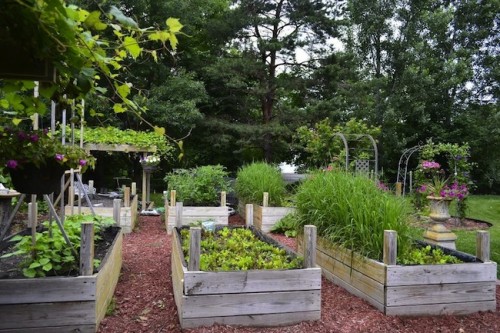Stay tick-free as you plant or play games in the yard, and keep cool indoors while pursuing creative wallpaper projects.
Garden smarter
This summer, no matter what you’re planting, whether vegetables to eat or flowers to look at, consider planting your chosen varieties in a raised-garden bed. Simple to build, even for beginning do-it-yourselfers, a raised bed enables you to control many of the factors that otherwise would be left to the whim of nature, namely soil nutrients, drainage and erosion. Not to mention, gardening “off the ground” helps reduce back strain — music to the ears of many, I’m sure.
The first step is to choose a location for your raised bed. Try selecting an area with exposure that lines up with the sunlight requirements of what you wish to grow. If unsure, opt for a spot that receives full sun for six to eight hours per day. Marshy sites are to be avoided, since root rot may be caused by water-saturated soil.
To frame your raised bed, use lumber, stone or hay bales; any number of common materials are appropriate for the purpose. Let style and budget guide your decision-making here. Inexpensive options include concrete blocks and pressure-treated lumber. (Important: Line any treated wood with plastic in order to prevent toxins from leaching into the soil.) Pricier options include brick and natural stone.
As you lay out the perimeter for your raised bed, remember that once planted, you’ll need to reach all the plants within the plot. For that reason, limit the width to three or four feet. The depth should be about one foot, unless you’re planning to add plants with deep roots, in which case it makes sense to build the frame about 18 inches high.
Fill the bed with a sandy clay-loam soil that’s been mixed with organic matter like compost. It’s also equally important to add mulch (try pine straw or mini pine-bark nuggets) after planting, as raised beds are prone to drying out. The task of watering becomes very easy if you outfit your bed with an irrigation system. As they don’t wet the foliage, which can cause mold, microsprinklers or soaker-hose systems work best.
After you’ve carefully planned and set up your raised garden bed, it’s finally time to start planting. This time of year, add seedlings of one or multiple varieties. Next year, you’ll enjoy one of the great advantages to this approach: Because the soil in a raised bed heats up faster, you’ll have a head start of about two weeks come springtime.
Make some backyard fun
Rather than piling into the car and heading for the amusement park, why not make your lawn the go-to destination? No matter how old you are, activities like ring toss and Bocce Ball can provide hours of entertainment right in your own backyard. In the past, you’ve probably gone at least a few rounds in horseshoes, but have you ever played Twister in the grass or tried super-size Jenga? Find old and new favorites in 10 DIY Lawn Games to Bring the Amusement Park Home.
Wallpaper something
Sure, a fresh coat of paint gives life to a tired room, but wallpaper adds color, design, pattern and dimension. Your taste and existing decor will narrow the field of choices, but don’t ignore some of the new faux wallcoveringsthat mimic the look of wood paneling, cork, marble and other materials. Do you have wallpaper scraps left over from previous projects? See creative ideas for reusing them in attractive and unexpected ways.
Keep your cool
Before you crank up the air conditioner this summer, give old-fashioned ventilation a chance. Keeping the air moving within your home can make it considerably cooler.
Of course, proper ventilation goes beyond simply opening a window. There’s a little science to it: If you live in a region where nights are cool, seal your house during the day. (Assuming adequate insulation, it should only heat up about one degree per hour.) In the evening and early morning hours, open windows to circulate cool air, ideally by means of cross-ventilation.
Minimize the amount of heat generated indoors by confining usage of the oven, dishwasher and clothes dryer to those times of day when it’s not so warm. Because even light bulbs can raise the indoor temperature, making the most of daylight is not only cheaper, but cooler as well. Finally, don’t forget about the under-appreciated window fan, which can bring about a summer breeze when all else fails.


